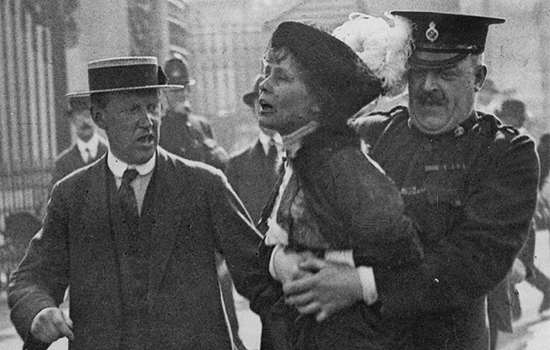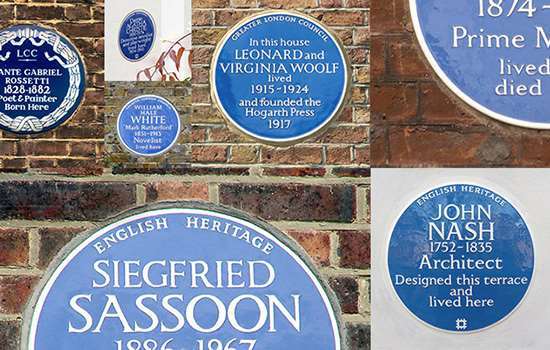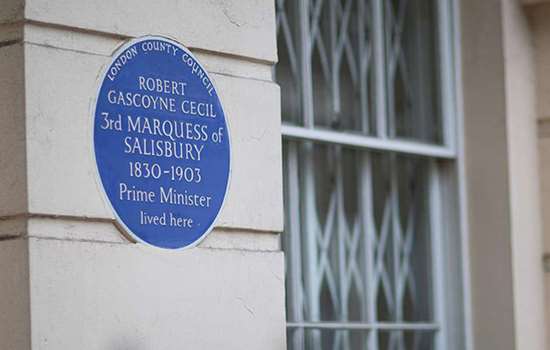Women’s Freedom League
Plaque erected in 2023 by English Heritage at 1 Robert Street, London, WC2N 6RL, City of Westminster
All images © English Heritage
Category
Philanthropy and Reform
Inscription
The WOMEN’S FREEDOM LEAGUE campaigned for women’s equality from here 1908–1915
Material
Ceramic
The Women’s Freedom League was a suffragist and equal rights campaigning organisation that worked on the principles of passive resistance and non-violence. Formed after a split in the Women’s Social and Political Union, it had its former headquarters at 1 Robert Street, Strand, which is marked with an English Heritage blue plaque.
Background and Foundation
The turn of the 20th century saw an upsurge in the fight for women’s emancipation and enfranchisement in the UK. In 1897, the National Union of Women’s Suffrage Societies (NUWSS) was founded by Millicent Garrett Fawcett. Suffragists made progress persuading politicians to support the cause, but the slow pace galvanised Emmeline Pankhurst into founding the more militant Women’s Social and Political Union (WSPU) in 1903. Taking the motto ‘Deeds Not Words’, the WSPU used direct action and disruption – earning publicity and the nickname ‘suffragettes’.
In 1907, disagreements within the WSPU led Emmeline Pankhurst to announce the cancellation of the annual conference and that a new committee would be nominated rather than elected. Her autocratic stance shocked many and a breakaway group declared that they would go ahead with the planned conference. It was attended by delegates from over half of the WSPU branches, and voted in a new executive committee.
‘Dare to be Free’: the Women’s Freedom League
The new organisation was named the Women’s Freedom League (WFL), signalling its aim to secure total emancipation for women. This was underlined by their 1908 motto: ‘Dare to be Free’.
Among the leading members were Teresa Billington-Greig (the first suffragette to go to prison), Charlotte Despard, Edith How Martyn, Caroline Hodgson, Annie Cobden-Sanderson and Margaret Nevinson. It was a democratic body with a collective leadership; the absence of a single figurehead seems to have served to give it a lower than deserved historical profile.
From the outset, the WFL defined itself as a militant suffrage organisation – the term ‘constitutional militants’ was sometimes used – but its leaders abandoned provocative WSPU-style tactics. Its own included targeting cabinet ministers at their homes and the non-payment of taxes, a campaign jointly organised with the Tax Resistance League. The WFL also led the way in the 1911 census boycott – in the words of Margaret Nevinson: ‘A very great act of rebellion that would really make the Government think.’
The WFL also brought an innovative approach to protest at Westminster. At the opening of Parliament in January 1908, members tried to present a petition to the king, reviving a traditional way to voice grievances. Later in 1908, three members protested in the Ladies’ Gallery in the House of Commons by chaining themselves to the metal grille which protected the MPs in the chamber. When in 1909 women’s suffrage was again omitted from the king’s speech, an airship was hired to distribute WFL pamphlets outlining the right to petition government. Prime Minister Herbert Asquith’s resolute refusal to meet with women’s suffrage deputations led the WFL to organise ‘The Great Watch’ that year – a continuous picket of the House of Commons.
Conscious of the need to convince more women to support suffrage – and to escape the contemporary equivalent of the ‘Westminster bubble’ – the WFL leadership initiated a caravan campaign to take their message outside the capital, and to rural communities in particular.
The WFL’s democratic structure enabled branches to devise their own strategies, such as highly effective bill-posting campaigns and a chemical explosion to sabotage ballot papers at the 1909 Bermondsey by-election. An official sustained a life-changing injury in this rare instance of violent protest.
The First World War and beyond
The outbreak of the First World War prompted a suspension of militant activism by the WFL, though it continued to campaign to end hardship and inequality experienced by women, and many of its members opposed the war. The League set up the Women’s Police Volunteers, who helped to maintain public order and offered protection to women in their communities. A settlement was founded in Nine Elms, Battersea, providing vegetarian meals, a children’s club and childcare provision. In 1915 the WFL set up a National Service Organisation, which acted as an employment agency for women. The WFL also joined an alliance of women’s organisations to protest against the return of compulsory treatment and detention of women infected with venereal diseases.
In February 1918 the Representation of the People Act was passed, enfranchising women over 30 years old who met a property qualification. However, the WFL continued to campaign for women to have the vote on the same terms as men, and this came to pass in the Equal Representation Act of 1928: Emmeline Pethick-Lawrence, its then president, declared that ‘our long campaign for political freedom is finally over’. Afterwards the organisation championed the cause of getting more women into Parliament and was not finally dissolved until 1961.
The Women’s Freedom League is usually ranked behind the WSPU and the NUWSS in significance, though one account states that it had 60 branches and 4,000 members, which is roughly comparable to the membership of the latter-day WSPU. It is remarkable not only for its campaigning methods but for their longevity and breadth: tellingly Helena Normanton, a WFL member, was supported by the League in her successful bid to become a barrister. The WFL archive forms the basis of the suffrage collection at The Women’s Library, now held at the London School of Economics.
The Building
On its formation in 1907, the WFL set up a London headquarters at 18 Buckingham Street, off the Strand. In May 1908 it moved a few streets away to 1 Robert Street, where the plaque is situated. Here it remained until June 1915, when it took premises (now demolished) at 144 High Holborn.
Number 1 Robert Street was built as part of the pioneering Adelphi development by Robert Adam and his brothers James and William between 1768 and 1774. The three-storey building, with attic and basement, was designed to house flats or chambers for letting, and is one of the few parts of the Adelphi development to have survived demolition in the 1930s.
The building was the WFL’s home when it was most active; its offices were probably on the first floor. There was a free library here of suffrage books and pamphlets by July 1910. The headquarters were busy and sociable: organisers met here to plan campaign steps, and sellers of The Vote and other pamphlets would have come here to collect copies.
Further reading
- Women's Freedom League, Oxford Dictionary of National Biography (Oxford, 2008) (public library subscription required)


